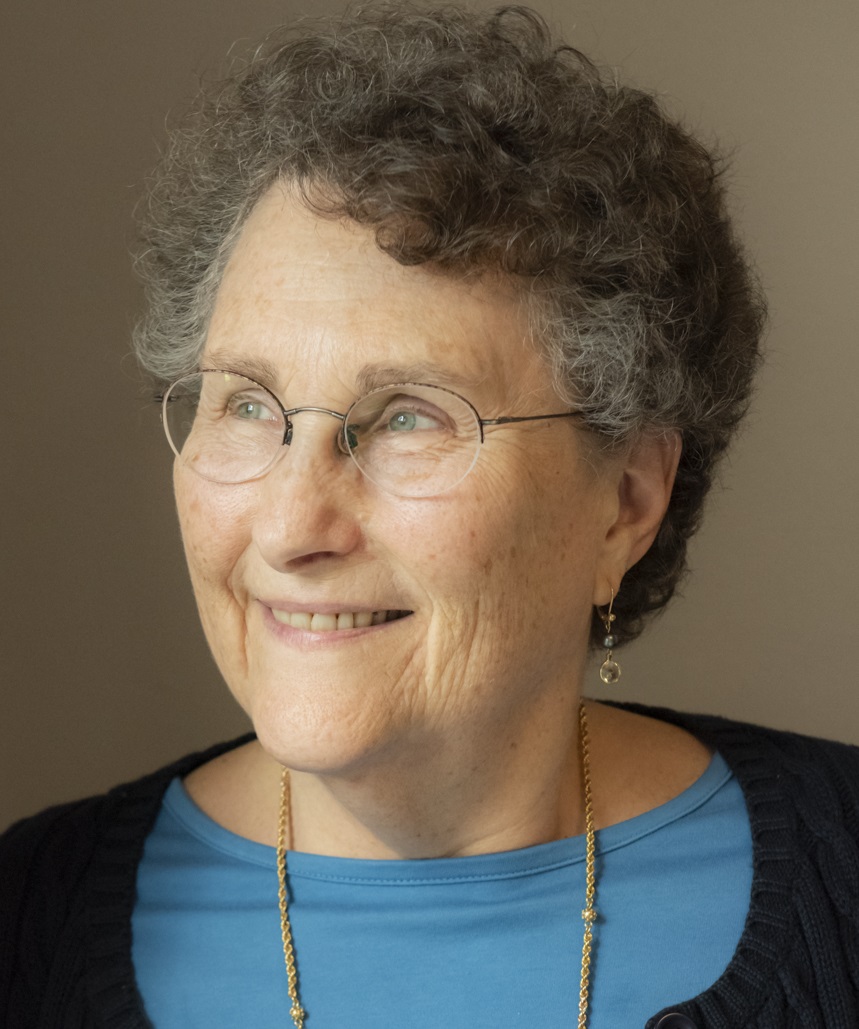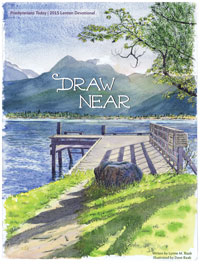Draw near: Praying about what we are looking for
Lynne Baab • Tuesday January 24 2023

Lutheran Bishop Michael Rinehart once got three speeding tickets in a year. The state where he lived, Iowa, required that he take a defensive driving course. At the end of the second class, the instructor asked to talk with him for a few minutes. The conversation that Bishop Rinehart describes is both amusing and thought-provoking.
“Why are you here?” he asked.
“Because I got three speeding tickets.”
“No, really, why are you here?” It was an existential question. I wasn’t sure how to answer. “Where are you going in such a hurry?”
“Well, the first time I was going to . . .”
“No, where are you going in such a hurry?” Ah, he meant in life. Again, I had no words. “Life is short. Take your time and enjoy it,” he said. Now he was preaching. “There is just a grave waiting for you down that road.” Ouch. Now you’re going to bring up my morality?
Then he pastored me: “What are you looking for?”
I had heard this question before. I had preached on it. Now it took on new meaning. What was I looking for in life that caused me to move so frantically through the world? I went home and looked up John 1. Two disciples follow Jesus, and he turns and asks them, “What are you looking for?” (John 1:35-42). [1]
When I read about this incident, I found myself wondering how I would respond if Jesus – or a driving instructor – asked me what I’m looking for. I wrote last week and the week before about the ways my parents’ pressure on me to conform squeezed out a lot of my awareness of what I actually care about and long for.
The gospel of John opens with gorgeous words about who Jesus was from all eternity and what his purpose was in coming to earth (John 1:1-18). The next 15 verses describe John the Baptist’s amazing baptism of Jesus, where the Holy Spirit descends and John becomes convinced Jesus is the Son of God.
Soon after that, John and two of his disciples see Jesus walk by, and John says, “Look, here is the Lamb of God” (verse 36). The two disciples turn away from John and walk behind Jesus, who turns to them and asks them, “What are you looking for?” (verse 38). The two disciples give a strange response, asking Jesus where he is staying. Jesus replies, “Come and see” (verse 39). These disciples of John stay with Jesus from then on. One of the two new disciples is Andrew, the brother of Peter. Andrew recruits Peter to come and follow Jesus by telling Peter that they had found the Messiah.
How I long for the immediacy those two disciples experienced. Jesus, there, in the flesh, talking in a human voice, asking them to think about what they were looking for, and inviting them to come and see where Jesus was staying and what he was doing. Somehow it seems that it would have been easier to discern what I’m looking for, who I’m called to be, and what it looks like to follow Jesus if only I could have seen him face to face.
And yet . . . Andrew, Peter, and that other anonymous disciple did not have the full gospel stories to read, like we do. They did not have the letters of Paul, Peter, and John. They did not have John’s revelation of the heavenly city where the sun is not needed because the glory of God is its light and its lamp is the Lamb (Revelation 21:23). They did not have the Holy Spirit, guiding and empowering them. When I look at the situation of those three new disciples of Jesus, they had to have been really bewildered by finding the Messiah in an unlikely person who talked about the kingdom of God in baffling and unexpected ways. We know from the gospel stories that over and over they are thrown off balance by Jesus’ teaching and the way he interacted with unexpected people.
The challenge for those early disciples, and the challenge now, is to turn to that one person, Jesus, and ask him to help us figure out what we’re looking for. And to ask him help us come and see, over and over, day after day. Jesus is present inside us in the Holy Spirit. Also by the power of the Holy Spirit, Jesus is among us as we gather with others who follow him.
As we ask God to help us come and see, we can ask for the Holy Spirit’s nudging to pay attention to the small and large miracles of life. God has helped me come and see – in fleeting moments, in wonderful times of blessed awe – and experience the presence of Jesus in the hugs of my granddaughter, music in worship services, prayers of friends, love and care that people give me, the beauty of mountains and water, and in the satisfaction I experience by living out my call to be a writer. Thank you, Jesus. Thank you, Holy Spirit.
What am I looking for? The guidance and power of the Holy Spirit to help me walk with Jesus. The awareness of God's enormous love for me, and for those I love. Most deeply, I am looking for peace and joy, so I can tell God I'm looking for the fruit of the Holy Spirit: love, joy, peace, patience, kindness, generosity, faithfulness, gentleness, and self-control (Galatians 5:22-23).
Amen, come Lord Jesus into our lives today. Help us come and see. Open our eyes to see your gifts and see who you are and where you're going. Help us recognize what we're looking for, and guide us to look for you and the things you value.
(Next week: Praying from a liminal space. Illustration by Dave Baab: Discovery Park Lighthouse, Seattle. If you’d like to receive an email when I post on this blog, sign up below under “subscribe.”)
The Sabbath is a time to slow down enough to “come and see” and identify “what are you looking for?” Resources on the Sabbath:
- My book, Sabbath Keeping: Finding Freedom in the Rythms of Rest
- The audiobook version of Sabbath Keeping
- My Bible study guide, Sabbath: The Gift of Rest
- Articles I’ve written on the Sabbath
[1] “January 15: Second Sunday after the Epiphany” by Michael Rinehart. The Christian Century, January 2023, page 25.
Next post »« Previous post
Subscribe to updates
To receive an email alert when a new post is published, simply enter your email address below.

Lynne M. Baab, Ph.D., is a teacher and writer. She has written numerous books, Bible study guides, and articles for magazines and journals. Lynne is passionate about prayer and other ways to draw near to God, and her writing conveys encouragement for readers to be their authentic selves before God. She encourages experimentation and lightness in Christians spiritual practices. Read more »
Lynne is pleased to announce the release of her book on grief and gratitude, designed to help people grieving from anything, including the pandemic, while also desiring to notice God's good gifts. Two Hands: Grief and Gratitude in the Christian Life is available in paperback, audiobook, and for kindle. Lynne's 2018 book is Nurturing Hope: Christian Pastoral Care for the Twenty-First Century, and her best-selling book is Sabbath-Keeping: Finding Freedom in the Rhythms of Rest (now available as an audiobook as well as paperback and kindle). You can see her many other book titles here, along with her Bible study guides.
Lynne recently spoke about empathy and also about bringing spiritual practices to life.
Lynne was interviewed recently for the podcast "As the Crow Flies". The first episode focuses on why listening matters and the second one on listening skills.
Here are two talks Lynne gave on listening (recorded in audio form on YouTube): Listening for Mission and Ministry and Why Listening Matters for Mission and Ministry.
"Lynne's writing is beautiful. Her tone has such a note of hope and excitement about growth. It is gentle and affirming."
— a reader
"Dear Dr. Baab, You changed my life. It is only through God’s gift of the sabbath that I feel in my heart and soul that God loves me apart from anything I do."
— a reader of Sabbath Keeping
Subscribe
To receive an email alert when a new post is published, simply enter your email address below.
Featured posts
- Drawing Near to God with the Heart: first post of a series »
- Quotations I love: Henri Nouwen on being beloved »
- Worshipping God the Creator: the first post of a series »
- Sabbath Keeping a decade later: the first post of a series »
- Benedictine spirituality: the first post of a series »
- Celtic Christianity: the first post of a series »
- Holy Listening »
- A Cat with a Noble Character »
- Welcome to my website »
Tags
Archive
- April 2024 (4)
-
March 2024 (5)
- Friendship, loneliness, and prayer: Praying about distractions from empathy
- Friendship, loneliness, and prayer: Praying to keep empathy flowing
- Friendship, loneliness, and prayer: Everyday initiative
- Friendship, loneliness, and prayer: Praying for guidance for ending conversations
- Friendship, loneliness, and prayer: Reflecting on the series
- February 2024 (4)
- January 2024 (2)
-
December 2023 (6)
- Friendship, loneliness, and prayer: Initiating
- Friendship, loneliness, and prayer: Praying about listening roadblocks
- Friendship, loneliness, and prayer: Praying to love the poverty in our friends
- Friendship, loneliness, and prayer: Praying for “holy curiosity”
- Friendship, loneliness, and prayer: Praying for “holy listening”
- Friendship, loneliness, and prayer: Praying to give affection extravagantly
- November 2023 (4)
-
October 2023 (5)
- Friendship, loneliness and prayer: A listening skill with two purposes
- Friendship, loneliness, and prayer: Saying “thank you” to friends
- Friendship, loneliness, and prayer: One more way reflecting helps us
- Friendship, loneliness, and prayer: Lessons from two periods of loneliness
- Friendship, loneliness, and prayer: Types of reflecting, a listening skill
- September 2023 (4)
- August 2023 (4)
- July 2023 (5)
- June 2023 (3)
- May 2023 (6)
- April 2023 (4)
- March 2023 (4)
- February 2023 (4)
- January 2023 (4)
- December 2022 (5)
- November 2022 (1)
- October 2022 (5)
- September 2022 (5)
-
August 2022 (6)
- Draw near: Confessing sin without wallowing
- Draw near: A favorite prayer about peace, freedom, and much more
- Drawing near with Desmond Tutu: God’s love is the foundation for prayer
- Draw near: Worshipping God with Desmond Tutu
- Draw near: Yearning, beseeching and beholding with Desmond Tutu
- Draw near: Praising God with Desmond Tutu
- July 2022 (2)
- June 2022 (6)
- May 2022 (5)
- April 2022 (6)
- March 2022 (5)
- February 2022 (4)
- January 2022 (3)
- December 2021 (5)
- November 2021 (4)
- October 2021 (5)
- September 2021 (4)
- August 2021 (4)
- July 2021 (4)
- June 2021 (4)
- May 2021 (4)
- April 2021 (5)
- March 2021 (4)
- February 2021 (4)
- January 2021 (4)
- December 2020 (5)
- November 2020 (3)
- October 2020 (5)
- September 2020 (4)
- August 2020 (4)
- July 2020 (5)
- June 2020 (4)
-
May 2020 (4)
- Spiritual diary of sheltering in place: The lifeline of separating thoughts from feelings
- Spiritual diary of sheltering in place: The lifeline of welcoming prayer
- Spiritual diary of sheltering in place: a kite string as a lifeline
- Spiritual diary of sheltering in place: The lifeline of God’s distant future
-
April 2020 (7)
- Spiritual diary of self-isolation: the lifeline of God’s constancy
- Spiritual diary of sheltering in place: The lifeline of accepting my place as a clay jar
- Spiritual diary of sheltering in place: the lifeline of memories
- Spiritual diary of sheltering in place: the lifeline of “Good” in “Good Friday”
- Spiritual diary of sheltering in place: The lifeline of “easier does not mean easy”
- Spiritual diary of sheltering in place: The lifeline of nature
- Spiritual diary of sheltering in place: the lifeline of God’s voice through the Bible
-
March 2020 (7)
- Important anniversaries in 2020: The first Earth Day in 1970
- Important anniversaries in 2020: Florence Nightingale was born in 1820
- Spiritual diary of self-isolation: Weeks 1 and 2
- Spiritual diary of self-isolation: God's grace as a lifeline
- Spiritual diary of self-isolation: The lifeline of limits on thoughts
- Spiritual diary of self-isolation: Wrestling with God for a blessing
- Spiritual diary of self-isolation: responding to terror by listening to Jesus voice
- February 2020 (4)
- January 2020 (5)
- December 2019 (4)
- November 2019 (4)
- October 2019 (5)
- September 2019 (4)
- August 2019 (5)
- July 2019 (4)
- June 2019 (4)
- May 2019 (5)
- April 2019 (4)
- March 2019 (4)
- February 2019 (4)
-
January 2019 (5)
- Nurturing friendships in a cellphone world: Jesus as Friend
- Nurturing friendships in a cellphone world: Friendship with Christ and friendship with others
- Nurturing friendships in a cellphone world: Who is my neighbor?
- Nurturing friendships in a cellphone world: Friendship as action
- Nurturing friendships in a cellphone world: Hymns that describe friendship with God
- December 2018 (3)
-
November 2018 (5)
- Connections between the Bible and prayer: Sensory prayer in Revelation
- First post in a new series: Nurturing friendships in a cellphone world
- Nurturing friendships in a cellphone world: Strong opinions and responses
- Nurturing friendships in a cellphone world: My conversation partners about friendship
- Nurturing friendships in a cellphone world: Two views about communication technologies
- October 2018 (4)
- September 2018 (4)
-
August 2018 (5)
- Providing Christian Care in Our Time
- Providing Christian care in our time: Seven trends in pastoral care today
- Providing Christian Care in Our Time: Skills for Pastoral Care
- Providing Christian care: The importance of spiritual practices
- First post in a new series: Connections between the Bible and prayer
- July 2018 (4)
- June 2018 (4)
- May 2018 (5)
- April 2018 (4)
- March 2018 (5)
- February 2018 (4)
- January 2018 (4)
- December 2017 (5)
- November 2017 (4)
- October 2017 (4)
- September 2017 (5)
- August 2017 (4)
- July 2017 (4)
- June 2017 (4)
-
May 2017 (5)
- My new spiritual practice: Separating thoughts from feelings
- My new spiritual practice: Feeling the feelings
- My new spiritual practice: Coping with feelings that want to dominate
- My new spiritual practice: Dealing with “demonic” thoughts
- My new spiritual practice: Is self-compassion really appropriate for Christians?
- April 2017 (4)
- March 2017 (5)
- February 2017 (4)
- January 2017 (4)
- December 2016 (5)
- November 2016 (4)
- October 2016 (4)
- September 2016 (5)
- August 2016 (4)
- July 2016 (4)
- June 2016 (4)
- May 2016 (5)
- April 2016 (4)
- March 2016 (5)
- February 2016 (4)
- January 2016 (4)
- December 2015 (4)
- November 2015 (4)
- October 2015 (5)
- September 2015 (4)
- August 2015 (4)
- July 2015 (4)
- June 2015 (4)
- May 2015 (4)
- April 2015 (6)
- March 2015 (4)
- February 2015 (4)
- January 2015 (4)
- December 2014 (5)
- November 2014 (4)
- October 2014 (4)
- September 2014 (4)
- August 2014 (5)
- July 2014 (4)
- June 2014 (7)





















